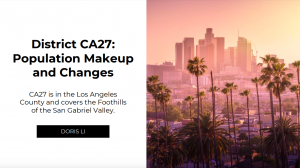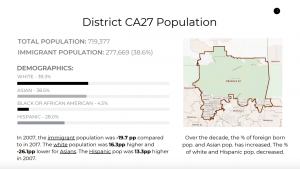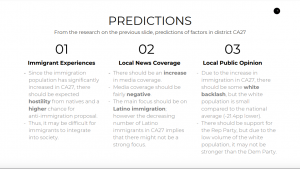

Slide 1: This slide covers the population makeup of California District 27. The foreign-born population of CA27 is fairly high, at 38.6%, compared the to national percentage at 13.7%. The largest subgroup of people in the district is white (non-Hispanic), at 39.3%, but the Asian population is close behind, at 38.5%. The Hispanic population is at 28%, still higher than the national statistic (17.6%). The smallest population group is black, at 4.5%. Ten years ago, the statistics were vastly different, in which the immigrant population was 19.7 percentage points lower than in 2017. Supporting this, the white population was much higher (16.3 pp higher) and the Asian population was much less (-26.1pp). Surprisingly, the Hispanic population was higher by 13.3 percentage points in 2007 than in 2017. Throughout the decade, there has been a steady incline of immigrants; thus, the population has morphed into one that is in higher concentration of immigrants, more specifically, the Asian population. The black and African American population stayed fairly stagnant at roughly 4%. Overall, the district has become more diverse as immigration has increased throughout the years, and has proved to house people of all origins harmoniously.

Slide 2: The second slide covers literature and research that studies the relationship between changing demographics and immigrant experiences, media coverage of immigration, and public opinion on immigration/immigrants. Daniel Hopkins, in “Politicized Places: Explaining Where and When Immigrants Provoke Local Opposition,” largely finds that as immigration increases in importance and relevance as an issue, there will be a higher chance for immigrants in an area with changing demographics to be faced with hostility from natives. He even finds that with a 8 percentage point increase in immigration, the chance of anti-immigrant proposal becoming considered doubles. Due to this, immigrant experiences may be quite negative in an area with increasing immigration, as natives become adverse with the increasing numbers. Abrajano and Hajnal, in White Blacklash: Immigration, Race, and American Politics, give reason for this in their work, stating that many see immigrants (Latino specifically) as dangerous, a burden to social welfare, and people who steal jobs from natives. Abrajano and Hajnal also study media coverage on immigration and immigrants, and conclude that the New York Times tended to cover immigration much more as the issue issue became more salient in the area. They find that the news coverage was mostly negative at 49% negative and only 12% positive and that it tended to focus on the Latino population. Branton and Dunway, in “Spatial Proximity to the U.S.-Mexico Border and Newspaper Coverage of Immigration Issues,” dove deeper into this, stating that news coverage near the border tends to focus on Latino immigration and typically feature the negative and illegal aspects of it. Media coverage affects public opinion, and Abrajano and Hajnal hypothesize that as immigration increases and a tendency for whites to view immigrants negatively, there will be white backlash and a greater support for the Republican Party. Because of this, there may be stricter immigration laws and more support for border enforcement and interior enforcement (Wong 2014). In general, there will be an increase in support for restrictive immigration laws.

Slide 3: This slide highlights the predictions that I make about district CA27 based off the literature from the previous slide. Because CA27 has increased in immigrants, we can predict that there will be white backlash and some of the immigrant population will be met with hostility. However, Abrajano and Hajnal’s findings rest on the assumption that natives view the Latino population quite negatively. The Latino population has decreased in size within the past decade, so there is no guarantee that the immigrant population in general will be met with hostility. In fact, Asian immigrants are generally seen more positively (Wong 2017) so we may see a different response than Abrajano and Hajnal have predicted. According to Abrajano and Hajnal, media coverage on immigration should be fairly negative, as the immigrant population has increased significantly. Thus, we predict that the tone of the articles should be quite hostile. Additionally, the focus should be on the Latino population. According to Abrajano and Hajnal, there should be white backlash against the increasing immigration population; however, the white population is only slightly above a third of the total population in district CA27 so there may not be backlash in the volume that Abrajano and Hajnal predict in their paper. Likewise, there should be support of the Republican Party from the white population, but due to the volume of the foreign-born population, the Democratic Party may be stronger. The chance that a restrictive immigration policy will be proposed if higher, but it will most likely not pass due to the Democratic representative and high immigrant population.

Slide 4: The last slide outlines a research plan to test the media coverage in district CA27. Since we are covering media coverage on the January government shutdown, the time period to search for articles should be within slightly before and after the shutdown. This will also give time to analyze the effects and potential backlash on the issue. Thus, the search period will be within late December and early February. Since we are searching for media on immigration, key search terms will include immigration, immigrant, border, wall, Mexico, and more. I will be judging tone based off the word choice in the articles (i.e. how they are connotated and what emotions they elicit in the reader) and whether the outlook on immigration in general is negative or positive. Framing will be determined based off whether the media is focused on a certain group of immigrants and whether they frame immigration issues as very important or minor. Lastly, I will be looking at salience of immigration by searching how many times immigration appears in a media source within a week and compare it to other topics covered by the source. The two media sources I plan to look at are NBC News Los Angeles and the Los Angeles Times. Both news sources cover the Los Angeles area and greater, which encompasses district CA27. I use both articles and videos to fully encapsulate the tone, attitudes, and framing of immigration from the media. Both are neutral or slightly left-leaning, so there should be little political bias involved.